By Judy Carmack Bross
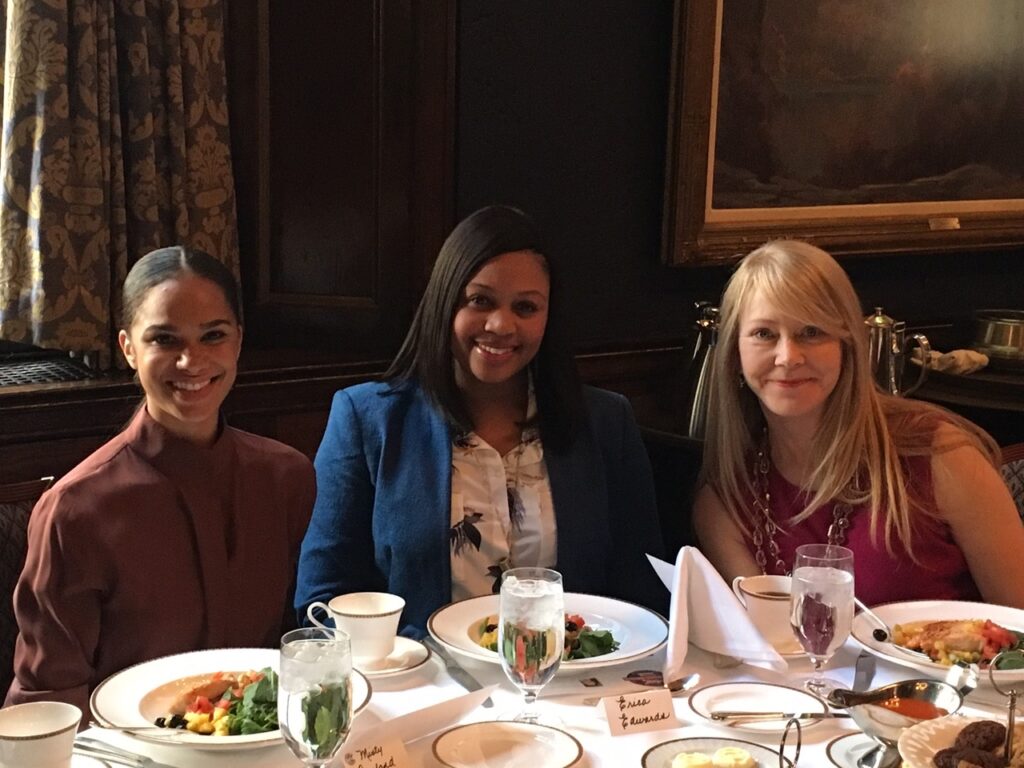
Ballet dancer Misty Copeland, left, DDP Board Chair Erica Edwards, who is Executive Director of Giordano Dance Chicago, and Liza Yntema in March 2017.
(Editor’s Note: In January 2019 we profiled Liza Yntema when she launched the Dance Data Project (DDP), predicting that it could not only transform the ballet community and impact the national and international arts environment but also change philanthropy for women. In marveling at her impactful results today, we recently asked Liza what it took and she said “persistence”. Authoring articles and op-eds and being the subject of interviews in The New Times, Forbes, NBC News Now and more, as well as numerous podcasts, she is shows daily how persistence and passion pay off.)
Since her arrival in Chicago in 1984, Elizabeth Yntema, better know as Liza, and her husband Mark Ferguson have devoted themselves to a number of causes around education and culture and she has been recognized as a hands-on volunteer and arts advocate. Despite moving back home to Boston–40 year-old promise from her husband, she maintains connections to a number of Chicago institutions, including WTTW, where she serves on the Board of Trustees, as well as the Women’s Board of the Field Museum of whose Women in Science program she is an enthusiastic proponent. Liza started her advocacy career at age 15, when “candy striping” at Mass General Hospital and with a persistent policy improvement question to a resident, she ended up serving on an all-hospital committee studying staff, volunteer and patient relations.. Yntema also received the Volunteer of the Year award from the Junior League of Chicago for her advocacy on behalf of homeless women and children. Her focus on strategic philanthropy has led to a number of guest teaching and lecture opportunities.
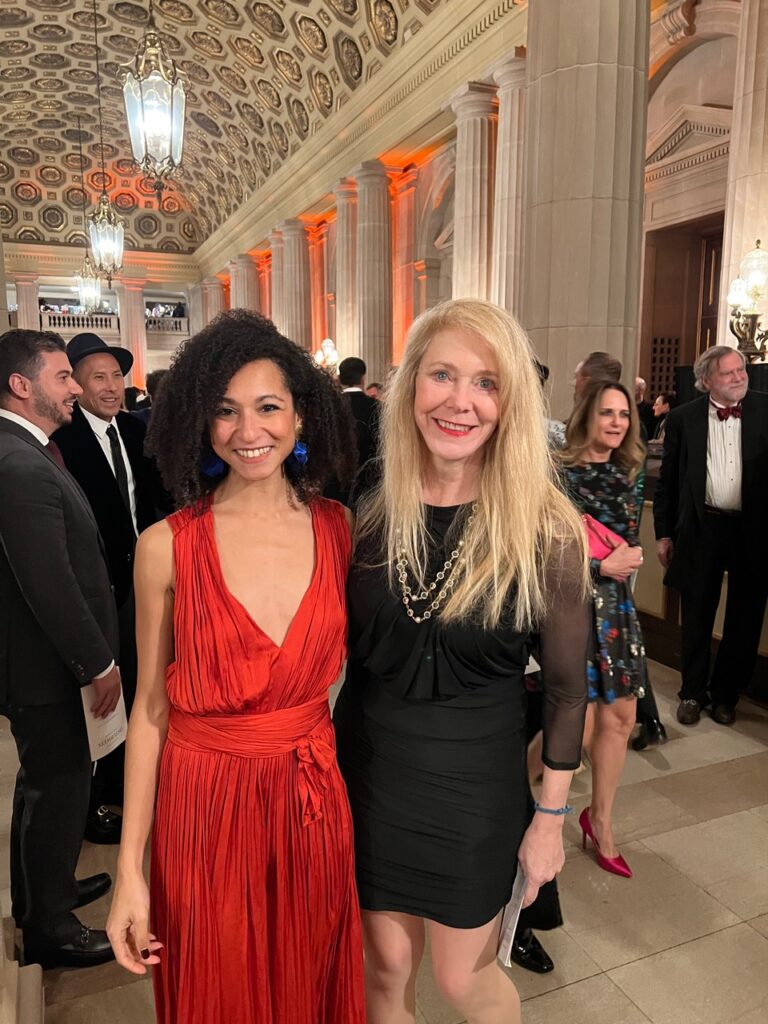
Liza Yntema with choreographer Claudia Schreiber at the Opening Night Gala 2023 for the San Francisco Ballet.
We wanted an update on DDP and learn more about the power of perseverance. Here’s what we learned from Liza:
CCM: Give us a quick DDP update. Are you seeing more women choreographers and in leadership advancing?
LY: With regard to women being given opportunities to dance run companies, it’s a mixed bag. A huge bright spot: when we started DDP, there was only one woman as Artistic Director of a Largest 10 ballet company. Now there are four: Susan Jaffe at ABT, Tamara Rojo at San Francisco Ballet, Julie Kent as Co-Director at Houston, and Lourdes Lopez at Miami City Ballet.
In terms of programming, last season was very disappointing – none of the Largest 10 featured a full length by a female choreographer. The “Bigs” or Largest 10 have an outsized influence – they make up 60 percent of the combined budgets of the Largest 50. This year already looks better, with San Francisco Ballet opening their season with Azure Barton’s Mere Mortals, which promptly sold out. Where ABT, San Francisco, and the Joffrey lead, others will follow. I give a big shout out to the Joffrey Ballet, who just announced their 2024-2025 season with a second full-length work, Atonement, in addition to a mixed rep work by Cathy Marston. It’s a huge statement and Ashley and Greg should be applauded. More good news for Chicago: Linda-Denise Fisher-Harrell has re-energized Hubbard Street Dance Chicago, and scored a major coup by bringing in Aszure Barton for a three year residency. On a national level, 2024-2025 season announcements are starting, and Kansas City Ballet in particular is doing a great job of commissioning women for more substantial work next year – a big leap towards opening up to new ideas and voices. Miami City and Charlotte Ballet have also announced full lengths by women. I just got back from seeing Annabelle Lopez Ochoa’s full evening ballet about CoCo Chanel at Atlanta Ballet.
CCM: Persistence and perseverance are to be prized in a world where everything is wanted faster and faster. The growing success of your DDP project exhibits these values, how have you made them work to live our your mission?
LY: Yes, there are absolutely hurdles to making an impact, especially on a small budget. Wholesale change is hard. Those who benefit from an insular, antiquated, word-of mouth-culture that rewards only a few don’t see why we would object to systematically excluding women from an economic sector that is estimated to be 73-84 percent female. Frankly, the performing arts, but especially dance, run on the unpaid or underpaid labor of women. We make up approximately 70 percent of the audience, the donor base, and the overwhelming majority–up to 20 to 1–of paying students in classes and academies but only about 30 percent of artistic directors nationally.
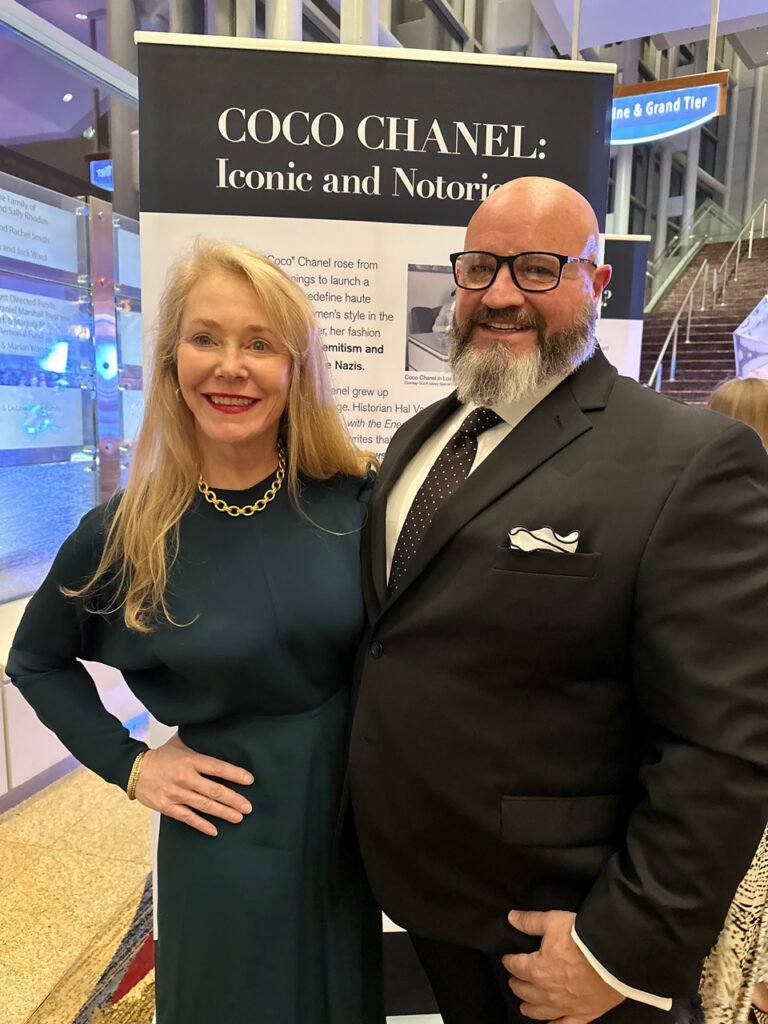
Liza and Tom West, Executive Director of Atlanta Ballet, whom she call “my current hero” for pushing for paying apprentices..
Things can change, however, especially if you recruit “outsiders” with more perspective. My personal hero of the moment is the Executive Director of Atlanta Ballet, Tom West, who came from Hollywood, saw that the apprentices weren’t being paid and said “We have to change this” despite being told, “well, it’s always been this way.” He made a deliberate, albeit costly, decision to promote fairness in policies.
When the world shutdown in 2020–we ramped up. People looked at me like I was crazy in 2019 when I shared that I had a tiny, fully remote team that worked asynchronously across the country. But then, COVID hit and Zoom became the norm. While other organizations tried to haphazardly learn what we had been doing all along, we just put our heads down and kept going and growing.
CCM: Growing up and in your earlier career, were these characteristics that were important to you? How would you tell people to best be persistent?
LY: It’s a delicate balance, right? Try, try again, assess. Not every idea will work. If you don’t give up, though, and keep learning and listening, every experience can be a building block. Also, I know a ton of smart women and lean on them shamelessly. When I give talks on strategic philanthropy I always say Chicago stands head and shoulders above everyone in terms of opportunities. It’s an incredible training ground, full of role models from Jane Addams onward. I think first of US Ambassador Fay Hartog Levin, who helped bring me onto the WTTW Board. Look at Trish Thomas and Nichole Wilson, incredible entrepreneurs doing great work at Every Body Eat, bringing yummy allergen-free products to market while employing the formerly incarcerated. Erica Edwards, the current President of DDP’s Board and Executive Director of Giordano Dance Chicago – one of the most energetic & inclusive women I know. They are exemplars of strategic leadership who actively seek out opportunities to promote other women.
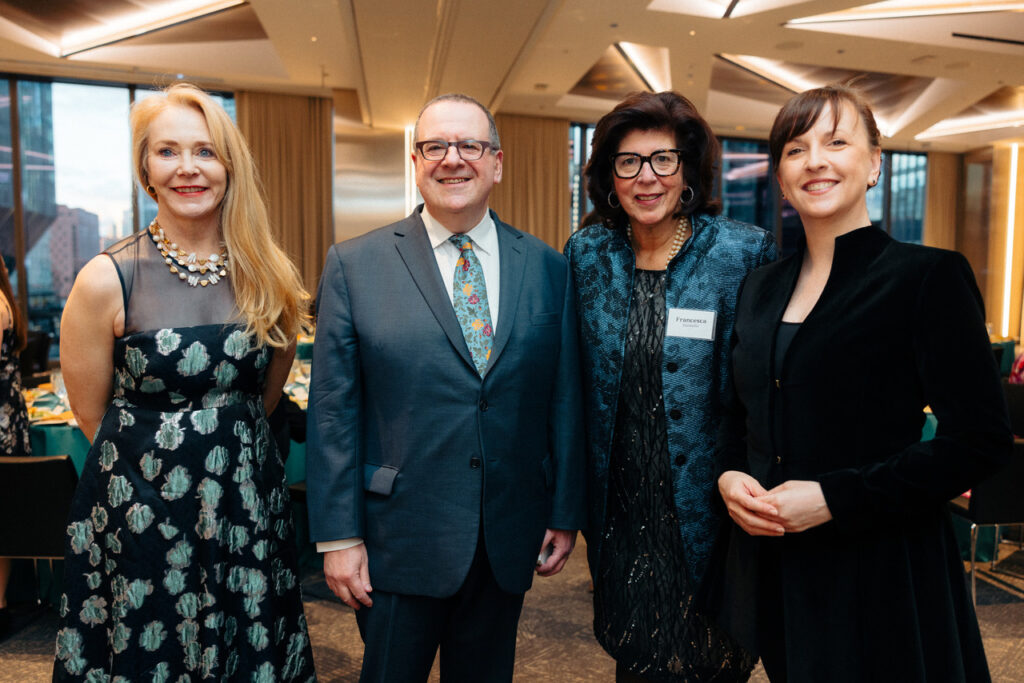
Dance Data Project founder Liza Yntema, Anthony Freud, General Director, President & CEO of Lyric Opera, Francesca Zambello – Director of Aida, and Jessica Lang-Segawa – Choreographer of Aida
In 1984, I came to Chicago knowing no one but my husband. The best decision I made was to join the Junior League of Chicago. I am still friends with so many of the amazing women I met through that experience, including Elizabeth Hurley, Deputy Director of the Lyric Opera. We just worked together on a production of Aida, directed by Francesca Zambello with choreography by Jessica Lang. This is my third round of support – I also was excited to support Stephanie Martinez of ParaMar and Camille Brown’s incredible work for Fire Shut Up in My Bones. It’s been fun, and I credit retiring Director Anthony Freud for recognizing the need to change – look at the newly announced season with two operas by women! As another great example of just hanging in there and being persistent: I credit Rich Regan at the Auditorium Theater for keeping the lights on with skeleton staff during the pandemic, being open to working with DDP on our Global Conversations interview series when the stages were dark. Global Conversations served a fundamental need during the pandemic, bringing 50 interviews to our network for free in just 14 months, featuring conversations with leading individuals across the world and connecting an industry that had been effectively shattered by lockdowns. Brilliant arts administrators like Rich and Claire Rice of the Arts Alliance Illinois should be celebrated for what they do for Illinois day in and day out.
CCM: How did you fall in love with dance and what about it most appeals to you?
LY: I started dancing at age 5. My mother had a big job in publishing, unusual for the time, and I was hyperactive: so soccer and ballet. I found another home in the ballet studio: structure and focus, combined with beauty and rigor. We were talking about the value of persistence and perseverance – ballet exemplifies those qualities. Every class starts with the same exercises, whether it’s your first class or your last. However, I am a straight up dance nerd — Irish dancing, Odissi, Bharatanatayam, ballet, flamenco — just knocks me out. I tried one Hip Hop class, wow, all respect to those dancers.
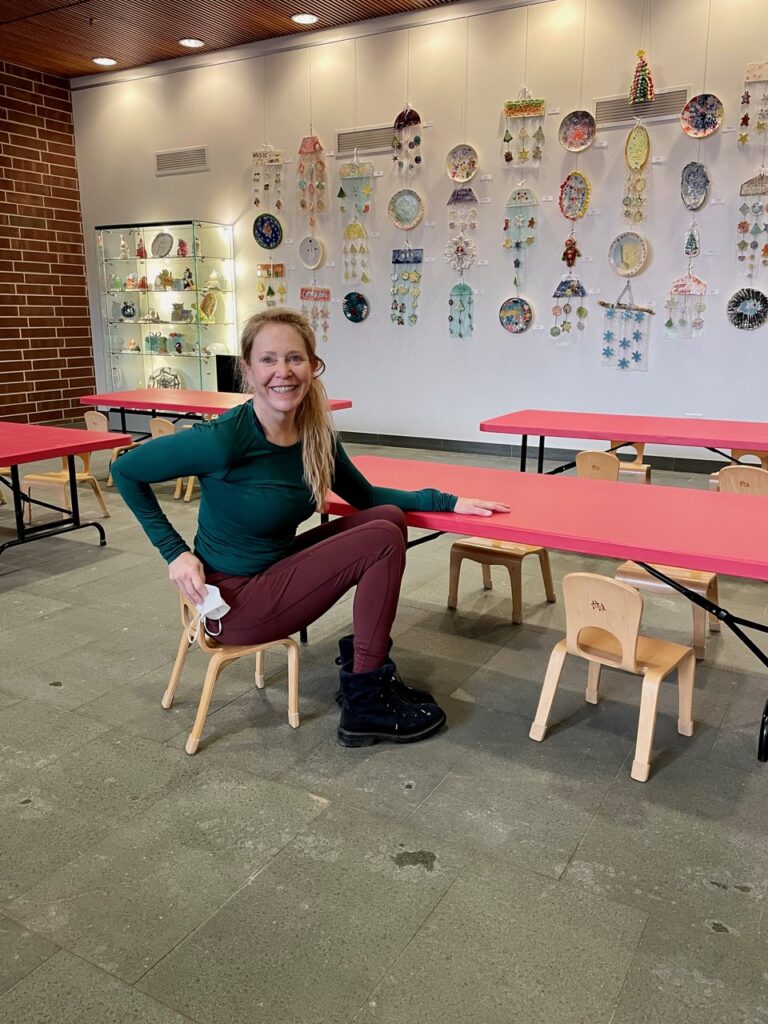
Liza says, “Don’t women deserve a seat at the big table?”
CCM: I know you began DDP concentrating on ballet, I believe that you are now broadening your scope?
LY: We have a dual strategy “Inside Out” to “Outside In”. in 2017, I started, literally at my kitchen table, with ranking companies by budget. So, for Inside Out – DDP began with the Largest 50 ballet companies because that is where the overwhelming proportion of money goes. We have since expanded to 150 US ballet companies, then to 50 and now 75 modern/contemporary American companies. Beyond ranking by size, we also look at pay and percentage of women in key positions. DDP now produces reports on festivals and venues, even dance departments at universities.
“Outside In” refers to DDP celebrating and giving a platform to regional US companies, who do critical work, sustaining an American arts eco-system in smaller markets, usually with little or no critical/press attention. With print news in contraction, the first thing cut is arts coverage, and within arts, usually dance critics are first to go. There is only one full time dance critic in the US now. That means no travel budgets, shortened stories and the dearth of reliable coverage. DDP provides a link between smaller companies or theaters and our growing international audience, including granting agencies, private funders and dance critics. We tell the stories no one else does. We have done 27 Listening Tours, spending time learning about the distinct flavor or culture of companies as diverse as Richmond Ballet, Ballet West, Kyle Abraham’s A.I.M. and Dallas Black Dance Theatre as well as Eugene Ballet. I am off to Oregon Ballet Theater next month – watching Wooden Dimes by their new Artistic Director, Dani Rowe.
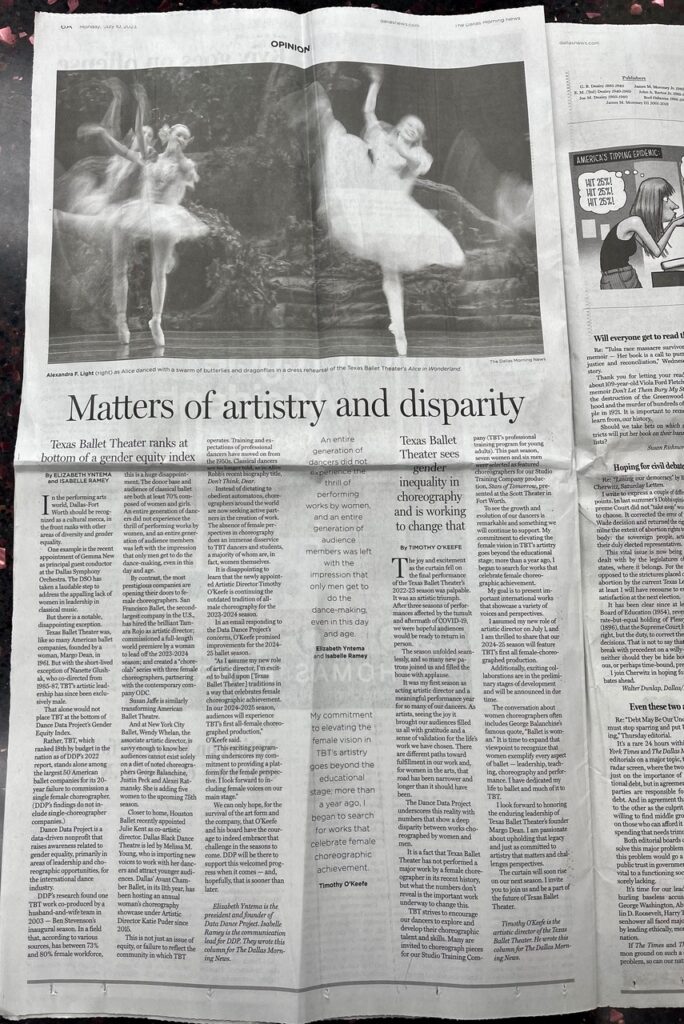
An Op Ed from Liza Yntema.
CCM: Your project has grown across the country, and now it looks like you might have international impact?
LY: We kept iterating, testing and expanding, now covering resident choreographers, artistic and executive directors, as well as heads of school globally. We are tracking approximately 350 companies, as well as international festivals and dance venues. Our Leader Board, tracking female leaders in all aspects of the industry and providing a tool for artistic director and choreographer searches, is now at about 1,087 names. That’s a massive expansion, and we manage it carefully. For the first time, DDP has also begun to analyze season programming as well. We intend to push out to study the season programming in Central and South America, Europe and then eventually companies, festivals and presenters throughout the world. It’s a global job and creative market, so DDP needs to track who is going where. There are some amazing women running companies that I would love to visit – Like Ingrid Lorentzen at Norwegian National Ballet.
CCM: What is it about you mission that is obviously resonating with people?
LY: Information is power. We are here to provide data and analysis which journalists, funders and advocates can deploy to create a more interesting, diverse dance world. Artistic director candidates have used our reports to demand pay equal to their male peers. Dancer representatives tell us that they negotiated a 40 percent salary increase based on our work. I am told all the time that female run companies cite DDP in grant writing. If we have a super power, it’s active listening. One of our mantras is “See a Problem – Solve a Problem.” So, for example, when I heard that female choreographers were devoting huge amounts of frustrating research looking into potential grant opportunities, I channeled my kids’ school application process, and we created a spreadsheet with all the details and list upcoming deadlines on a Home Page banner – it’s one stop shopping.
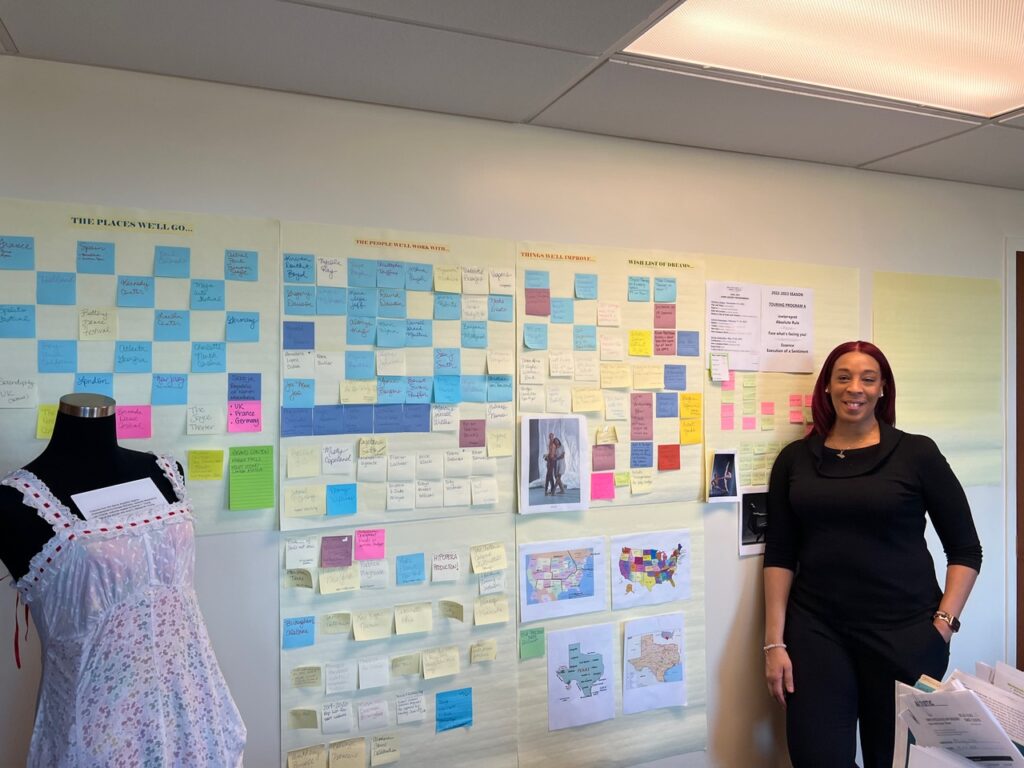
Melissa Young, Artistic Director of the Dallas Black Dance Theatre envisions progress.
Everyone is busy, doing a job the best they can in a high pressure environment, living in a bubble. Whether it’s business or the performing arts, it’s not easy being the woman in charge. Even long tenured female artistic directors had no real concept of how big the salary and commissioning gap was. Women often speak to me about how isolated they feel, afraid of failure, with no one with whom they can share challenges. Through our programming, we help the Next Gen of women to succeed, help prepare candidates for interviews, and provide role models to young women. I also connect potential candidates and search firms, and provide behind the scenes coaching, encouraging women to apply for leadership positions. I would love to create a Women’s Leadership Forum, where either virtually or some day in person, women can share struggles but also support strategies.

Lecturing at the 2022 Corps De Ballet conference
CCM: You have been called a disruptor… How do you respond?
LY: Oh boy… thank you? At least I come by it honestly. The women in my family have been activists for generations. My great great grandmother wasn’t permitted a medical degree, despite doing all the classwork. My great grandmother was a strong suffragist and organizer for the League of Women Voters. My grandmother, Jean Busey Yntema, who graduated in 1920 as one of two women from the University of IL with a degree in chemistry, was an advocate for racial and gender equity and a pioneer in environmental conservation, helping to create Illinois Beach State Park.
CCM: You use statistics and facts to present your information. How did you choose this direction?
LY: Numbers don’t lie. It’s important that everyone in the arts sector, in this case dance, be aware of pay and opportunity gaps. I find it extraordinary, for example, that a major US ballet company, one of the largest 20, can go 21 years, an entire generation, without commissioning a single woman, not even an in-house pas de deux by a company dancer. That means a generation of audiences, dancers, staff or journalists have never seen a woman at the front of the room. How is that ok? Just like investing in a company, due diligence is important. Just going to a performance and not thinking about those on and behind the stage, how they are paid and treated, isn’t ok. They are real people, with extraordinary skills and deserve to be treated fairly and compensated at a living wage.

Toni Primble, Artistic Director of the Eugene Ballet with a headpiece. She also sews costumes.
CCM: There are the large companies in major cities, tell us about smaller dance companies in smaller cities.
LY: We have so many talented companies in the Chicago area, Deeply Rooted, classical Indian. But around the country, look at BalletX, the artistic director Christine Cox, has created a super highway for new choreographers with over 130 world premieres in 18 years. Look at Tallahasee Ballet, for a tiny gutsy company, operating in a strong football town. How about the crazy brave folks starting new ballet companies even during the pandemic? – Deos Contemporary Ballet in Grand Rapids, Ballet Collective, New England Ballet Theatre, Dance Aspen to name a few. Ballet West has climbed into the Largest 10 on the strength of innovative programming, despite being in a relatively small market – Salt Lake City – incredible company, with a real commitment to new voices.
CCM: Women choreographers are gaining new positions but is this happening fast enough? What can the public do to accomplish this?
LY: We as taxpayers are actually the primary stakeholders in not for profits. Dance companies, symphonies, orchestras, museums, like other not for profits have a duty to serve their communities. Whether you are an audience member, individual donor, or serve as a grant administrator for a foundation, you have the duty, but also the opportunity, to make change, to push for more newer, more varied voices – whether composers, choreographers, set, costume or lighting designers. Let’s not forget also that there are very well-paying union jobs, like electricians, that are still overwhelmingly white and male. directors? Not sure, one could ask the same question about tech, private equity, financial services and the sciences. What I do know, what we are doing now, as funders, just isn’t working. The sector is aging, and shrinking. The NEA has released some of their own analysis of the 2022 data. Overall, the audience for ballet dropped 37 percent between 2017 and 2022, and audiences for other dance forms dropped by almost half, per National Endowment for the Arts finding.
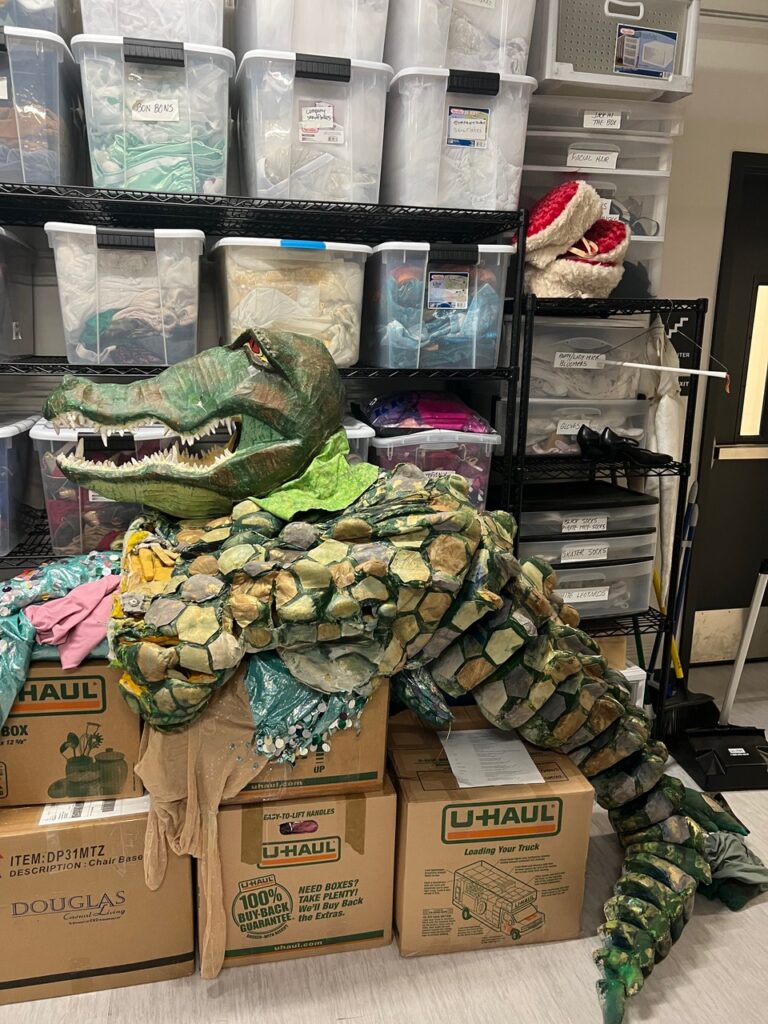
My favorite thing to do, visit the Costume Shop – this time Eugene Ballet
CCM: What didn’t you envision when you started DDP?
LY: What has been literally a daily joy, is that we have created a talent generator for so many brilliant young women, who can now see a pathway to being both a dancer and a computer engineer, a performing arts professional and a math nerd, follow an interest in applied math while focusing on a career in ballet. Look at our incredible Team members, including three extraordinary high school interns for whom I have had the honor of writing college recommendations. One of them, Quinn Andrews-Myers, is right here in Chicago! We hear from so many women and girls that our work sustains them. As the Geena Davis Institute notes, “If she can see it, she can be it.”
Besides that, the opportunity to champion so many incredible artists –who work in almost impossible conditions, all over the world and particularly in very small rural areas throughout the United States. They inspire me. So many have become dear friends. I love being a small part of their success stories, helping any way I can.
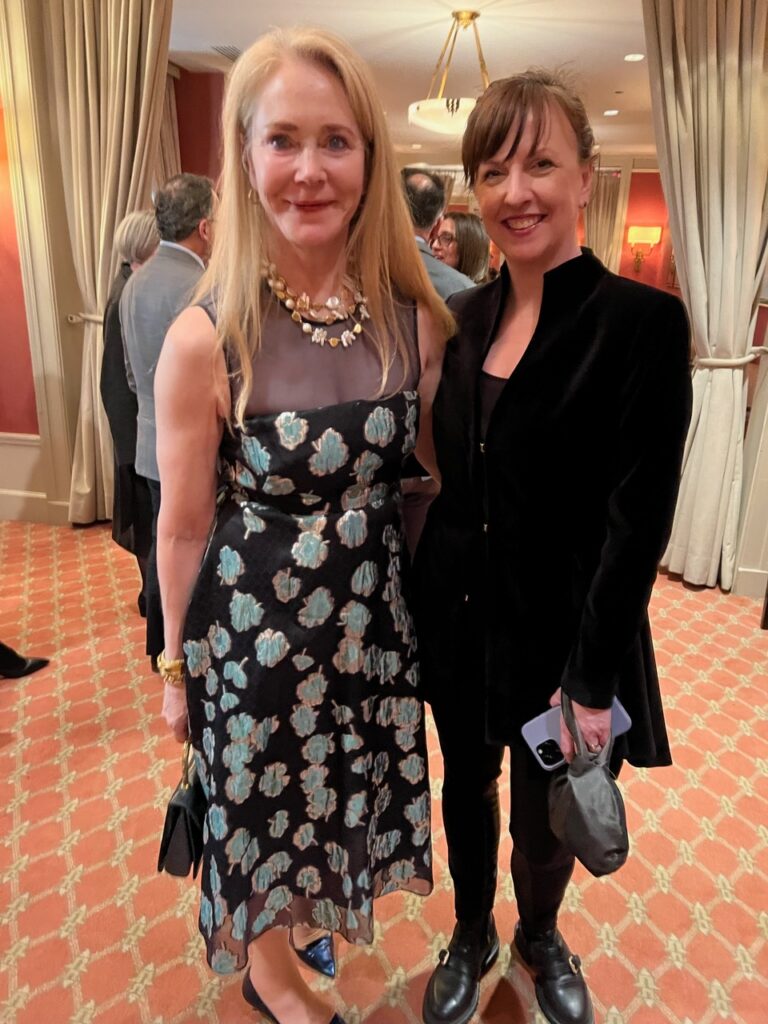
Elizabeth “Liza” Yntema and Jessica Lang-Sagawa, choreographer, at premiere of Aida at Lyric Opera
For more about the Dance Data Project visit: dancedataproject.com

